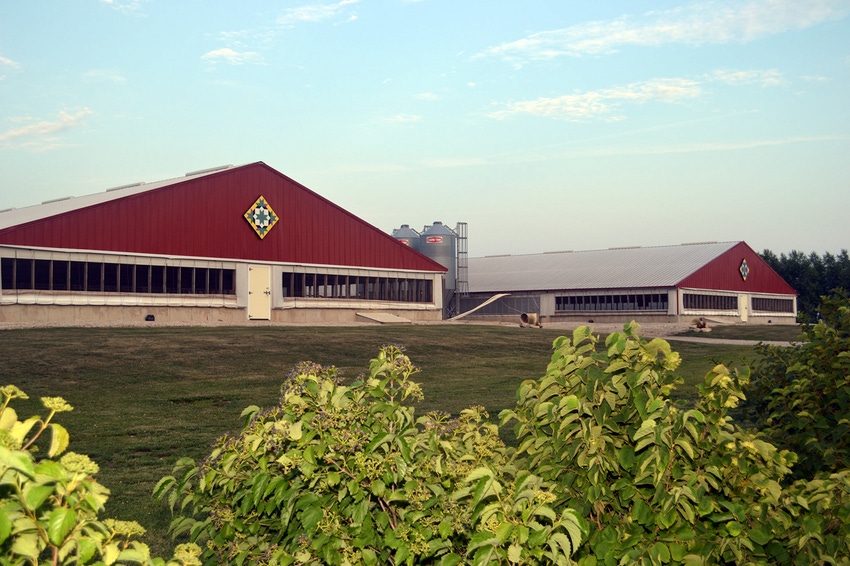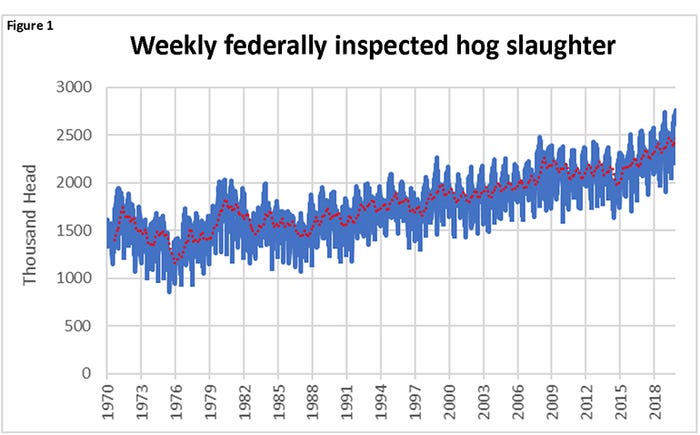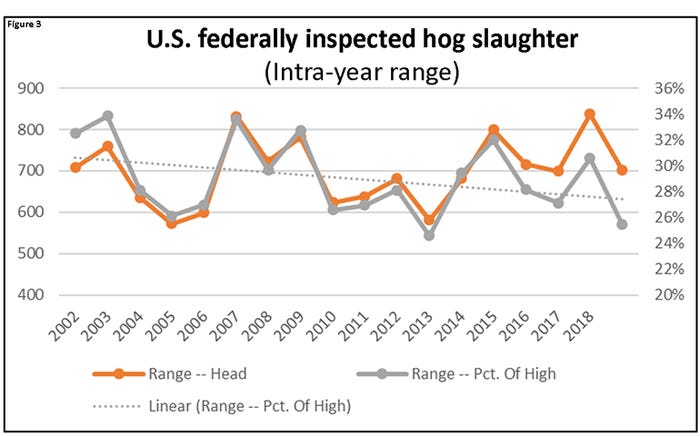Hog market driven by seasons, cycles and trends
Continued experimentation by producers and their input suppliers may uncover an "anti-seasonality" gem.
December 2, 2019

Sometime in the late 1990s, Professor Glenn Grimes, Ron Plain and perhaps John Lawrence and I had a somewhat lengthy discussion about the future of variation in hog supplies and prices. The first thing to take from that sentence is that I have for many years been blessed with the opportunity to hang around many people much smarter than I am! That's a list of sharp people who this industry can truly be thankful for. At least the first three, but I digress.
Hog supplies and prices have been driven by all of the three major forms of variation: Season, cycle and trend. The seasonal and cyclical variations in quantity and price are intrinsically related. Trends in supply and price are not nearly so. Production trends are driven primarily by population growth and technology. Lesser drivers are sustained changes in demand, whether positive or negative and domestic or foreign. Price trends can be affected by all of those, plus sustained changes in currency values.
The focus of the discussion that day, though, was cyclical and seasonal variation. At that time, the "hog cycle" was the classic example of a more- or less-regular, repeating cycle of pork supply and an opposing cycle of hog prices. Both cycles ran roughly four years from trough to trough, and peak to peak and provided helpful guidance in forecasting hog prices. I never saw a chart of it, but it was claimed that the hog cycle could be traced well back into the 1800s.
When I was in college, the logic of the hog cycles was that producers would see good prices, expect them to continue and increase production. The result, of course, would be lower prices which producers would then expect to continue thus driving them to reduce production. The primary mechanism for the production swings was the entry and exit from hog production of a large number of farmers. We called them "inners and outers."
I never quite bought that farmers of any ilk were as naïve as the hog cycle explanation indicated. The farmers I knew were smart and would quickly learn that they couldn't expect good times or bad times to continue forever. They would figure it out.
In fact, they did. A better explanation was offered by Plain: Expansion occurred when producers had cash from profitable hog sales and the good will of their spouses and their bankers. Contraction occurred when they ran out of cash and had their spouses and bankers urging them to do something different.
But what if the "inners and outers" went away? Prior to the mid-'90s, pasture-based production was common in much of the United States. Rows of wooden huts of various shapes would be stacked in the fence rows during bad times in the hog market and then moved out and stocked when things got better. New-fangled "confinements" on the other hand ran pretty steady regardless of conditions. In fact, Plain's 1980 dissertation at Oklahoma State concluded just that: If you own a high-investment hog facility, the best long-term strategy was to run it full. In other words, you couldn't out-guess the market enough to overcome high fixed costs!
The move to "confinement" production systems in the 1990s was the death knell for the hog cycle. It is clear in Figure 1. The weighted average trendline smooths appreciably in about 2000.

But what's the deal with the saw teeth in the chart? Those represent seasonal variation and it is, to some surprise, still alive and well.
The same conversation involved how seasonal variation might go away with the advent of "climate-controlled" hog barns. No longer would sows and boars be subjected to the high heat of the summer or the frigid temps of winter. Conception rates and litter sizes would stabilize. Hog farms would reach their version of nirvana: The same number of pigs weaned every week.
So much for theory. Figure 2 shows clearly that the range from the low week of the year (almost always the week containing July 4) to the high week of the year for number of head slaughtered has remained more-or-less constant.

Figure 3 confirms that for the gap itself in head (orange line). In fact, the spread in 2018 was record large in terms of head.

The spread in terms of percentage of the high week is trending slightly lower over time. But it has only dipped below 25% in one year — 2013, and that year was likely impacted by porcine epidemic diarrhea virus.
So why is seasonality still so pronounced? Primarily, it hangs on because it is difficult to fool Mother Nature. Though we have definitely improved the climate in which much of our breeding herd now lives, we haven't removed all of the variation. B/G barns still get warmer in the summer. Day period can likely still be recognized through translucent curtains. Biological rhythms don't just disappear.
Second, temperatures still have a larger impact on grow-finish barns. Higher summer temperatures reduce feed intake and slow pigs' growth rates, moving some pigs out of the summer months and into the fall. Cooler weather increases feed intake and growth rate, pulling some pigs forward — an impact that likely lasts all winter.
Third, feed palatability has the same impact as temperatures. Old crop corn gets less tasty as summer progresses. Feed intakes and growth rates lag, pushing hog toward the fall. New-crop corn does just the opposite, pulling some pigs forward beginning in September.
You only have to shift supplies for a few days to create a large amount of seasonal variation. And it appears that, in spite of our efforts to stop the shifting, it goes merrily along.
What do we do about it? I'm not sure much can be done that hasn't already been tried. Producers have a huge incentive — higher prices in the summer and lower prices in the fall. And so do packers who have always needed larger plants to handle fourth quarter supplies and had to scale back utilization rate (i.e. increase unit costs) in the summer.
Both groups stand to gain from smoothing seasonal variation. Some new technology may, of course, solve part or all of the problem but producers have been keenly aware of this issue for years and have, I think, tried about every trick — that they know of.
That last point is important. Just because we don't have an answer now, doesn't mean we won't have an answer forever. Continuing experimentation by producers and their input suppliers may uncover an "anti-seasonality" gem. This might be a needle in a haystack. We might need to look for different needles in different haystacks, but the important aspect is to keep on looking.
Source: Steve Meyer, who is solely responsible for the information provided, and wholly owns the information. Informa Business Media and all its subsidiaries are not responsible for any of the content contained in this information asset.
About the Author(s)
You May Also Like





